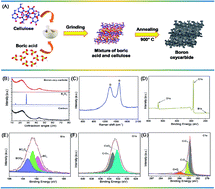Carbothermal conversion of boric acid into boron-oxy-carbide nanostructures for high-power supercapacitors†
Abstract
In this study, we report a facile carbothermal method for the preparation of boron-oxy-carbide (BOC) nanostructures and explore their properties towards electrochemical energy storage devices. The formation of lamella-like BOC ceramic nanostructures in which boron suboxides are confined in the carbon matrix was confirmed using high-resolution transmission electron micrographs and X-ray photoelectron spectral analyses. A symmetric supercapacitor (SSC) fabricated using BOC electrodes demonstrated their stable operation over a wide voltage window of 2.0 V in the TEABF4 electrolyte. The BOC SSC possesses high capacitance (7.26 mF cm−2), high energy density (14.53 mJ cm−2) with better rate capability, and a long-life cycle. Further, BOC SSC possesses a low equivalent series resistance (1.44 Ω), which in turn leads to the achievement of a high maximal power density (373 mW cm−2) that makes it a better alternative to the reported silicon- and carbon-based supercapacitors. In addition, we have also demonstrated a self-charging power system via extrinsically integrating BOC SSC with a thermoelectric power station that further highlights their applications in next-generation energy storage and management sectors.

- This article is part of the themed collection: Journal of Materials Chemistry A Lunar New Year collection 2022


 Please wait while we load your content...
Please wait while we load your content...